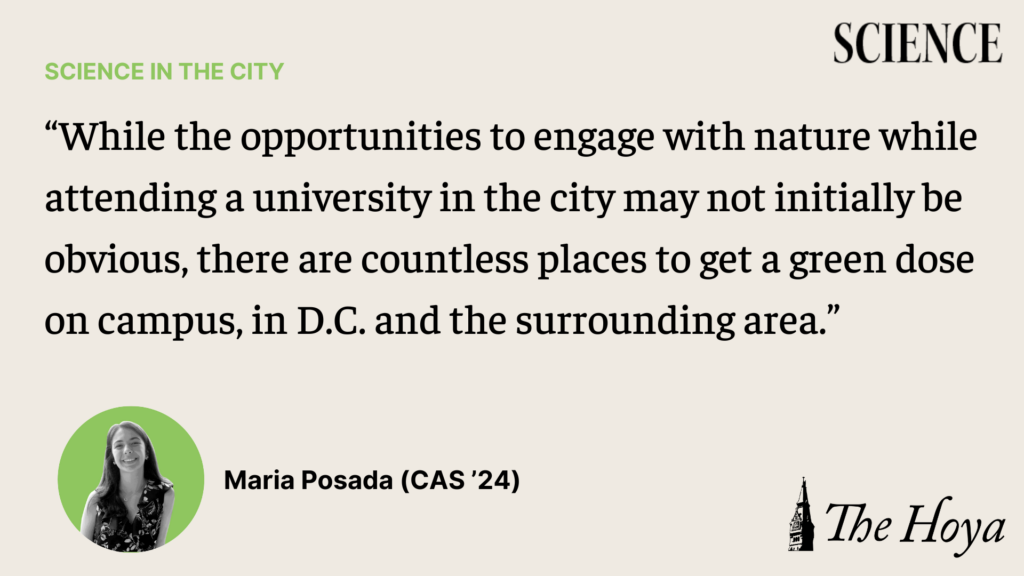Georgetown University’s fast-paced environment and urban setting make it challenging to slow down and engage with nature. Balancing work, school and social lives can be hard enough, leaving little time to break the so-called “Georgetown bubble.” Yet, engaging with nature provides us with countless benefits that can be especially helpful during our stressful college years, yet our campus often overlooks the natural havens nearby.
The ongoing mental health crisis on college campuses highlights the glaring need for accessible treatment and support. According to a 2023 survey from the Healthy Minds Network, a research group that studies youth mental health, 41% reported depression and 36% reported anxiety. While there is not a cure-all solution to this crisis, a growing body of research has supported the profound effect that exposure to nature can have on mental well-being.
According to NatureRX, a collection of resources encouraging individuals to connect with nature that Georgetown’s Earth Commons Institute compiled, spending time outside can help reduce stress, enhance mood, improve sleep and benefit our physical health and cognition. Research shows that as little as 10 minutes of daily exposure to nature — providing opportunities for physical activity and socialization — can have a transformative impact on the mental health of college students. This time in nature allows for an escape from pollution and noise, cultivating a sense of belonging with our surroundings.
Engaging with nature helps us care not only for ourselves but also for the earth. A 2019 study by the International Union for Conservation of Nature, a collection of research groups and government organizations that recommend policies to support nature conservation, found that connectedness to nature is a strong predictor of positive conservation behavior.
It’s clear that time in nature can have profound impacts on our minds, bodies and planet, but how can we engage with the earth with limited time and while living in a city? Fortunately, there are great ways to engage with nature on our own campus, whether it’s relaxing on the front lawn or exploring the grassy spaces by Georgetown’s Heyden Observatory, our campus provides us with manifold spots for a quick dose of nature.
The Hoya Harvest Garden, located on the Regents Hall fourth-floor patio, also allows students to learn about our shared responsibility for our common home and to get their hands in the mud during their weekly fall harvests.

If you want to burst the Georgetown bubble and get walking, we are lucky to live near the Glover-Archbold Trail, which connects the observatory to Van Ness St. The flora and serenity of this trail, as well as nearby paths on Theodore Roosevelt Island and Rock Creek Park, will make you forget you are in the middle of a city.
Dumbarton Oaks Park Conservancy, which is just a short commute away on R St., provides a similar escape from the city, as well as an opportunity to see the design of Beatrix Farrand, the nation’s first female landscape architect. Dumbarton Oaks frequently hosts volunteer days, during which you can learn about invasive species management and contribute to local conservation efforts by cleaning up the park and taking inventory of species on the trails.
If you find time to venture further afield, the D.C. area is filled with beautiful hikes less than an hour’s drive away from Georgetown. Outdoor Education, a department of Georgetown University Center for Student Engagement that teaches students about the natural world through wilderness trips, leads two trips most weekends to local hikes, including the iconic Old Rag Mountain in Shenandoah National Park, Harpers Ferry Overlook Hike in historic Harpers Ferry, W.Va. and Billy Goat Trail in Great Falls, Md. Signing up for one of these hikes is an easy way to go hiking while attending Georgetown, as you won’t have to worry about planning routes or finding transportation.
While the opportunities to engage with nature while attending a university in the city may not initially be obvious, there are countless places to get a green dose on campus, in D.C. and the surrounding area. If you can, try to make plans for at least ten minutes outdoors every day — maybe even carve out time for a monthly Outdoor Education trip.








